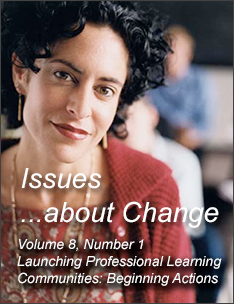Collective Learning and Application of Learning
Research reveals that in learning communities, persons at all levels of a school work collaboratively to solve problems and improve learning opportunities. Together, they seek new knowledge and skills as well as ways to apply their new learning to their work. This collegial relationship produces creative and satisfactory solutions to problems, strengthens the bond between principals and teachers, and increases commitment to improvement efforts (Griffin, cited by Sergiovanni, 1994).
In this dimension, the entire staff (or a significant portion of it) comes together to learn about relevant issues that affect work with the students. Co-Developers reported that in each of their schools staff learning of some kind was occurring. Some schools were working with the entire staff and providing time to meet and learn. Other schools were working with the leadership teams, which met weekly to review and discuss schoolwide issues. However, few descriptions were provided of how or if this staff learning was actually being applied to instructional practices in the classroom. Instead, the Co-Developers reported the content of staff learning and the process of staff learning. They then used this information to guide their initial work with the school staff in this dimension.
The Content of Staff Learning
Co-Developers reported that most staff learning in schools related directly to curricular concerns. Several Co-Developers acknowledged the role of state and district mandates in determining what will be learned, initiating teacher dialogue about their work, and encouraging alternative instructional practices. New accountability standards often required schools to examine where their areas of success and lack of success were apparent in student achievement. Some principals used these standards to promote the need for re-examination of accepted practices. One Co-Developer reported:
The state-mandated testing and accountability program has forced schools to re-examine what they are teaching, how they are teaching it, and how students are doing. Faculty members must cooperate and collaborate with each other in order to improve the curriculum, instruction, and ultimately student scores. (Co-Developer B)
In some cases the mandate was handed to staff with very little of the training needed to carry out the task. In one case the Co-Developer helped the school staff address the curricular requirements of the mandate:
Here we have a group of teachers under the gun [due to low student achievement scores] back on the first day, and looking for an instructional strategy. . . aligned with brand new standards and benchmarks. What's more, the question included how might we write such a strategy in a district approved lesson plan format. At this point, I said something like, "I don't know if y'all are interested, but I just happen to have a little instructional strategy here in my pocket. It's aligned with six of the seven K-12 Language Arts content standards". . . . Swift consensus was noted by all. It is amazing how this can happen when given an assignment by the principal, with short time to comply. (Co-Developer L)
When training did occur, teachers were often expected to share what they learned with other staff upon their return to the school.
The principal believes in sending her teachers to meetings and conferences so they will continually learn and then come back and implement what they learned and share with the faculty as a whole what they have learned. In other words, they will become their own staff developers. (Co-Developer M)
The Process of Staff Learning
Co-Developers identified the process the school staff used for learning. They determined if the entire staff was coming together to learn and, if not, who was coming together and how often. Understanding current practices would help the Co-Developers alter the learning environment to better reflect a PLC. Schools used a variety of ways to involve school staff.
Co-Developers sometimes used their own skills to help teachers interact with one another about the subject of their inquiry and learning. For example, one Co-Developer used dialogue as a means to share ideas, practices, and innovations implemented by peer teachers.
In several instances, printed or visual resources were used by the principal or Co-Developer to elicit discussion about their teachers' practice. One Co-Developer described the excitement that emerged from teacher involvement in a jigsaw activity on a reading selection about professional learning communities. She interpreted their response as a desire to continue learning together.
To me, this spark of enthusiasm reflected a deeper fire within the teachers to learn and study together. (Co-Developer D)
The same Co-Developer then introduced the idea of faculty study by using a video on brain-based learning and constructivist teaching. By discussing the content of the video, the Co-Developer provided the teachers with an idea of what a faculty study "could be like."
Another Co-Developer used focus group interviews to identify themes for school improvement. Later, these themes were shared with the staff and used to initiate faculty study.
Using the themes as a focus for faculty study, the group was introduced to the whole-faculty study group process developed by Carlene Murphy. This model was selected because it provided the structure they missed during their work during the first semester. The focus group interviews refueled a frustration with how to study together. They expressed, "We need direction. Where is the structure?"
Several Co-Developers reported that they either helped design or simply participated in staff retreats away from the campus. In one case the school staff went on a weeklong science retreat together to be immersed in "hands-on" training in a real learning environment. The benefits of this experience extended beyond the learning they gained in the subject area; it also strengthened collegial and personal relationships.
We carpooled, stayed in a dorm, ate meals together and were immersed in the various aspects of the K-5th-grade science curriculum. The staff gained a deeper understanding of the curriculum and each other. (Co-Developer O)
Next Page: Supportive Conditions

